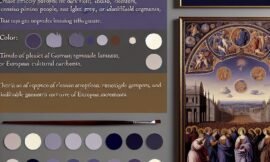The world of painting is vast and diverse, offering a myriad of techniques to explore. One such technique that stands out for its tactile nature and visual impact is impasto painting. Known for its thick paint application and the resulting textured effects, impasto has been a favorite amongst artists for generations. This blog post delves into the fascinating universe of impasto, tracing its history, exploring its application, and providing tips for those eager to master it.
The Rich History of Impasto Painting
Origins of the Impasto Technique
The impasto technique finds its roots in the Renaissance era, a period marked by groundbreaking innovations in art. Early adopters like Titian began experimenting with thicker applications of paint to add depth and dimension to their works. This departure from the norm paved the way for a new form of expression in painting that was all about texture and physicality.
Evolution Through the Centuries
As centuries passed, the impasto method evolved, finding prominent use in the works of Baroque painters like Rembrandt, who utilized it to bring dramatic lighting effects to life. Moving into the 19th century, artists like Van Gogh and later Monet leveraged impasto to heighten the emotional and tactile aspects of their art, allowing their brushstrokes to convey mood and motion.

Understanding the Technique: How to Achieve Texture in Art
What Makes Impasto Unique?
Impasto painting is distinguished by its three-dimensional texture, acquired through the thick application of paint. This method not only adds a tangible quality to the painting but also plays with light and shadow in intriguing ways. The ridges and peaks created by the technique can catch light, enhancing the painting’s dynamism.
Application: Tools and Techniques
The process of impasto involves using tools like thick brushes, palette knives, or even fingers to apply paint liberally to the canvas. The choice of tool and pressure applied can significantly affect the final texture. For artists new to this technique, it is advisable to start with heavier mediums such as oil paints, which are naturally suited to retaining brush strokes and thickness.
Famous Artists and Their Signature Styles
Van Gogh’s Emotional Brushwork
Perhaps one of the most famous practitioners of impasto was Vincent Van Gogh. His works, like ‘Starry Night,’ are a testament to how thick paint application can invoke emotion and rhythm. The swirling, dynamic patterns created by his heavy brush strokes are iconic, inviting viewers not only to see but to almost ‘touch’ the emotional state of the artist.
Monet’s Play with Light
Claude Monet employed impasto to capture the ephemeral qualities of light and atmosphere. His series, such as the ‘Water Lilies,’ showcases how the tactile surfaces of the canvas can be manipulated to represent natural phenomena like reflections and breezes, transcendently bringing nature to an almost immersive state within the gallery.
Impasto in Contemporary Art and Digital Realms
New Frontiers in Modern Impasto
In today’s art world, impasto continues to inspire, with many contemporary artists pushing the technique even further. Artists like Anselm Kiefer and Frank Auerbach use impasto to explore conceptual themes, engaging with history and memory through their heavily layered canvases.
Impasto Meets the Digital Age
The digital realm has not been left untouched by the influences of traditional techniques like impasto. Digital artists are now using software to simulate impasto effects, creating art that blends the tactile richness of traditional painting with the limitless possibilities of digital mediums. Tools like Corel Painter and Photoshop allow artists to mimic texture in art digitally, bridging the gap between classical methods and modern technology.
Tips and Tricks for Mastering Impasto
Starting with the Right Medium
For beginners hoping to experiment with thick paint application, starting with oil or acrylic paints is recommended due to their forgiving nature and slower drying times. These mediums allow for more manipulation and experimentation as you get accustomed to controlling texture.
Experimenting with Tools and Techniques
As you dive into impasto, don’t shy away from mixing tools and methods. While palette knives are a staple for achieving crisp, bold textures, brushes can offer a subtler approach. Try different combinations to see what resonates with your artistic vision.
The Dynamic Interaction of Color and Texture
Color Retention and Light Play
The nature of impasto allows colors to remain vibrant, as they sit on the surface rather than being absorbed by the canvas. This effect is magnified by the play of light on the textured surface, which can create dynamic shifts in perception.
Creating Mood Through Texture
Texture, joined with color, can evoke strong emotional responses. A chaotic storm can be captured through aggressive, erratic strokes, whereas a serene landscape would benefit from gently swept trails of paint, proving that texture is as much a part of storytelling as color itself.
In conclusion, the impasto technique offer artists a rich, multidimensional means of expression. Whether used to convey emotion, capture light, or simply explore the potential of paint, impasto adds a new dimension to both traditional and digital art realms. As you explore this technique, remember that the heart of impasto lies in its ability to transform two-dimensional works into living, breathing entities full of life and depth. Embrace the texture, and let it enhance your artistic dialogue.






